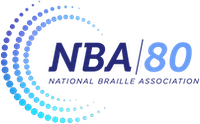claurent
Forum Replies Created
-
AuthorPosts
-
claurent
ParticipantIn my opinion, your TN says that graphs will not have switches...not that they can't be within switches. Leave Nemeth open until after the table. The closing switch indicator would go by itself in cell 1 after a blank line following the closing box line. If you wanted, you could modify your TN slightly to reflect that...something like "Cartesian graphs are created in Nemeth whether or not they are enclosed within Nemeth switch indicators."
Cindi
claurent
ParticipantThat's a good question! BF does not directly address this. I would suggest that you use the print page number that actually appears on your volume. So for volume 3, the TOC entry would use 739.
Cindi
claurent
ParticipantDo you know what DNE means?
I would agree with your inclination...to close at the end of Question 2 and open again after the identifier for 7.
Cindi
claurent
ParticipantIf I am understanding your question...the notes are being put into each volume with the material to which they apply, right? Per BF 16.9.2b "Endnotes at the end of a book generally are divided and placed at the end of the volume in which the references appear." So the notes are placed at the end of each volume and should keep the print page number that applies - in this case, 738.
Let's say that the notes for Chapters 1 & 2 appear on print page 738 in the print text. Let's say that each chapter is one volume - so Chapter 1 is in volume 1 and Chapter 2 is in volume 2. At the end of volume 1 is print page 738 with the notes for Chapter 1 and at the end of Volume 2 is print page 738 again with the notes for Chapter 2.
In the Volume 2, Table of Contents, the contents for Chapter 2 would be first followed by a blank line and then the Notes page showing print page 738.
Does this answer your question? If I have misunderstood the question please clarify 🙂
Cindi
claurent
ParticipantIt seems to me you have two options:
- Leave it where it is in print and then put a brief embedded TN after each time it is mentioned before you actually get to it - something like "Figure 1.1 TN on page a35 TN" OR
- Move it to where it is first mentioned in the text, reference it's location when needed and then put a TN on the print page where the figure actually appears - TN Figure is moved to page a27 TN.
If you move it you also need a TN stating that the figure is moved from page ... so in my opinion, the "cleaner" method is to leave it where it appears in print and just put in embedded TNs to let the reader know where to find the figures.
If the placement is very consistent and it can be explained on the TN page you could avoid all the embedded TNs by putting something on the TN page like "The figures mentioned in the text appear at the end of each section." Of course, to do it that way, they must ALWAYS be that way in print 🙂
Cindi
claurent
ParticipantBecause the parentheses need to be in the same code, your transcription is the best option.
Cindi
claurent
ParticipantYou should use whichever reference indicator is applicable. In the example you've attached, I would think the UEB reference indicator would be appropriate - but I would need to see how you transcribed it to know for sure. If you are within Nemeth switches, use the Nemeth reference indicator. If you are outside the Nemeth switches, use UEB reference indicators. BE SURE that the indicator used within the text matches the one used with the actual note at the bottom of the print page in braille.
Cindi Laurent
claurent
ParticipantI should have also said that Lindy is on vacation this month so I am answering these for her 🙂
Cindi Laurent
Chair, NBA Nemeth Committee
claurent
ParticipantThe [NC 4.8.9 and 26.4.5] are reference to the Nemeth Code Book (which has not yet been published and is not available to the "public" yet).
Yes, the preferred method (after much discussion) for author's comments is that they are blocked four cells to the right of the runover position of the material to which they apply.
Cindi
claurent
ParticipantI would just ignore the boxes. The text explains what the reader is looking at. However, if you decide to retain the boxes, you should use the rules for shapes with interior modifications (which is what you did).
Cindi
claurent
ParticipantThere is no rule in UEB or BF that requires abbreviations to stay in the same line as the material to which they apply. That's a Nemeth thing. 😁
Cindi
claurent
ParticipantIn my opinion, the guidelines are clear that only the title page and supplemental title page are single spaced. The special symbols page and transcribers notes page are double spaced.
Cindi
claurent
ParticipantI apologize for not replying sooner - our system glitched and this just popped up!
My understanding was that only the title page(s) were single spaced. But Bonnie Read wrote the rules 🙂 This confuses me as well. Just reading the guidelines, I would say only the title pages...and the guidelines are what we should follow.
Cindi
claurent
ParticipantWow - those are really messed up! I would be interested to know how you handled this! I would say that a TN would be required that the numbered lines cannot always be determined and you did the best you could to reproduce them as required.
Cindi
PS - sorry for not responding quicker, our system glitched and I just saw all these old posts pop up!
claurent
ParticipantSorry for the delay in responding. According to BF 6.2.2c: When an illustration has a source citation, place it immediately following the caption using 7-5 margins.
Cindi
-
AuthorPosts
